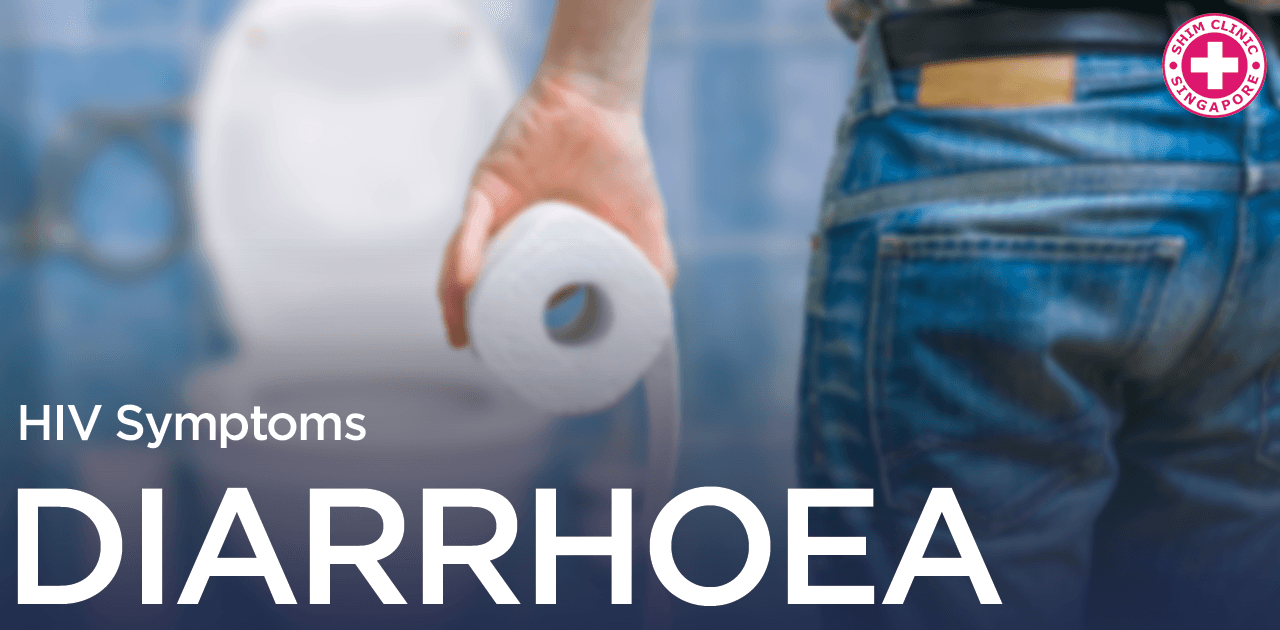HIV Diarrhoea Singapore | Shim Clinic
| Help me about HIV Diarrhoea ! |

| Permalink: https://shimclinic.sg/hiv-diarrhoea |
A very common symptom of acute HIV infection is diarrhoea. This symptom can also be a side effect of HIV medications. It’s very important to stay hydrated if you have diarrhoea. To know whether it’s due to HIV or another cause, you’ll need to get an HIV test, which is the only way to know for sure.
The first stage of HIV infection, called acute HIV infection or primary HIV infection, can have a wide variety of symptoms. These can resemble more common viruses like “the flu” or “the stomach flu,” although acute HIV infection tends to last longer. It doesn’t begin right away after the exposure, but instead symptoms begin 2 to 4 weeks after being exposed. The symptoms can then linger for several weeks. By contrast, symptoms of more common (and less serious) viruses are usually gone in about a week.
Among the common symptoms of acute HIV infection is diarrhoea. This may occur along with other gastrointestinal symptoms, such as nausea and vomiting, but not always. The severity of diarrhoea may range from loose stools to watery diarrhoea. A potential complication of diarrhoea is dehydration. It’s very important to ensure that you stay hydrated if you have diarrhoea, particularly if it’s watery. Plain water is not as effective for hydration as solutions with a bit of salt and sugar, such as Pedialyte. If you get very dehydrated, you may need to go to the hospital for IV fluids.
Diarrhoea is also a common side effect of HIV medications. Those taking these for any reason, whether it’s because they have an HIV infection or they’re taking HIV PEP or HIV PrEP to prevent an infection, may experience diarrhoea. It’s important not to stop taking your medication because of this side effect. Your doctor can give you a prescription to help you manage the symptoms.
- Diarrhoea is a very common symptom of the early phase of HIV infection, called acute HIV infection.
- Diarrhoea is also a common side effect of HIV medications.
- Staying hydrated is very important if you have diarrhoea. Consider drinking a solution like Pedialyte instead of plain water for more effective hydration.
- Many other diseases also cause diarrhoea. Even if you also have other HIV symptoms such as fever and rash, the only way to diagnose HIV is with an HIV test.
Although diarrhoea is a very common symptom of acute HIV infection, it can also have many other causes. Gastrointestinal illnesses, including viruses acquired on surfaces (such as sink handles and doorknobs) and food-borne pathogens, are very common causes of diarrhoea. Other diseases, such as coeliac disease, can also cause diarrhoea, particularly when certain foods are consumed. There are many other potential causes. Having diarrhoea, even if you also have other HIV symptoms such as fever and rash, doesn’t necessarily mean that you have acute HIV infection. You need an HIV test to determine whether that’s the true cause of your symptoms.
In order for your doctor to do the right type of HIV test, you must be honest about any potential exposure to HIV that you’ve had, and when they might have occurred. Your doctor might not realize that your symptoms are HIV symptoms if he or she doesn’t know that you’re at risk for HIV. Tell your doctor about unprotected sex, a condom breaking or leaking, sharing any equipment for injecting drugs, or any other possible HIV exposures, to get the HIV test you need.
Sources:
Mayo Clinic. “STD symptoms: Common STDs and their symptoms.” Mayo Clinic. Published 18 Mar 2015. Accessed 20 Jul 2016. http://www.mayoclinic.org/std-symptoms/art-20047081
Centers for Disease Control and Prevention. “Screening Recommendations Referenced in Treatment Guidelines and Original Recommendation Sources.” Centers for Disease Control and Prevention. Published 04 Jun 2015. Accessed 20 Jul 2016. http://www.cdc.gov/std/tg2015/screening-recommendations.htm
Centers for Disease Control and Prevention. “HIV/AIDS.” Centers for Disease Control and Prevention. Published 05 Jul 2016. Accessed 27 Jul 2016. http://www.cdc.gov/hiv/
Centers for Disease Control and Prevention. “HIV Basics – Testing.” Centers for Disease Control and Prevention. Published 12 Jul 2016. Accessed 20 Jul 2016. http://www.cdc.gov/hiv/basics/testing.html
U.S. Department of Health & Human Services. “Post-Exposure Prophylaxis (PEP).” AIDS.gov. Published 21 Sep 2015. Accessed 20 Jul 2016. https://www.aids.gov/hiv-aids-basics/prevention/reduce-your-risk/post-exposure-prophylaxis/
| Timeline | HIV | STD | Pregnancy |
|---|---|---|---|
| Before exposure | |||
| Contraception (females only) | |||
| HIV PrEP (pre-exposure prophylaxis) - Stop HIV infection before exposure | STD vaccine: - Hepatitis vaccine - HPV vaccine | ||
| STD / HIV exposure | |||
| 0-72 hours | HIV PEP (post-exposure prophylaxis) - Stop HIV infection after exposure | STD testing * - Screening test - to look for asymptomatic infections - from previous exposures | Emergency contraception with the morning-after pill (females only) |
| 2 weeks | HIV DNA Test | ||
| 1 month | HIV 4th Generation Test - SD Bioline HIV Ag/Ab Combo - Fingerprick blood sampling. - 20 minutes to results | ||
| 3 months | HIV 3rd Generation Test - OraQuick® HIV-1/2 Antibody - Oral fluid or - Fingerprick blood sampling. - 20 minutes to results | STD testing * - Full & comprehensive - diagnostic test - to look for current infections | |
| Watch for | HIV Symptoms | STD Symptoms | |
| If infected | HIV Treatment | STD Treatment | Abortion |
References